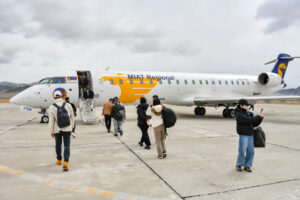Participation in the Medical Screening in Bayan-Ölgii Province
8/16/2025
We received a very detailed report from Dr. Shun Yanai, who participated in the regional medical examination conducted in Bayan-Ölgii Province during Golden Week 2025, and we would like to share it with everyone.
Participation in the Medical Screening in Bayan-Ölgii Province
Shōwa University School of Medicine
Pediatric Cardiology and Adult Congenital Heart Disease Center
Shun Yanai
This year, I once again had the privilege of joining a regional medical screening as part of the Heart Saving Project (HSP)—something I had long hoped for. Since my first participation in 2005, I’ve had the opportunity to visit many different regions across Mongolia, but this time, I was informed that we would be traveling to Bayan-Ölgii Province, located at the westernmost edge of the country. I had heard before that this province is predominantly inhabited by ethnic Kazakhs, many of whom speak only Kazakh rather than Mongolian. A colleague who had previously taken part in a screening in Bayan-Ölgii once told me that the scenery was breathtaking and encouraged me to go if I ever got the chance. So from the moment I learned I would be part of this dispatch, I was very much looking forward to visiting the area.
Looking up “Bayan-Ölgii Province” online now, I can find all sorts of pictures and information. But at the time (perhaps using my busy daily life as an excuse), I didn’t research the destination in depth. Instead, I simply focused on preparing for the temperature differences and ensuring I had all necessary daily items for the trip.
In previous regional screenings, even in areas that felt quite remote by Japanese standards, we mostly traveled by car. So when I learned that this time we would be flying on a domestic flight, I felt the distance in a new and more tangible way. I was slightly concerned about the longer duration of this screening compared to past trips, but there was no point in worrying. More importantly, we had a reliable coordinator accompanying us, and Dr. Haneda would also be there—so I waited for departure without much anxiety.
April of this year was particularly busy with many critically ill patients. The day before departure, I had no choice but to stay overnight at the hospital. But I was able to hand over care responsibilities to my colleagues and managed to catch the Narita Express in time.
At Narita Airport, I met up with Dr. Ono, Dr. Tabe, and Ms. Koeda, who was joining the project for the first time. We were able to complete our departure procedures without any issues. Narita was busy around 2 p.m., and it took over an hour from the time the airplane doors were closed until takeoff. This delay made me somewhat anxious, but we arrived safely in Ulaanbaatar. To our great surprise and honor, two members of parliament from Bayan-Ölgii Province had come all the way to the airport to welcome us, despite our delayed arrival. Their warm reception left a strong and positive impression.
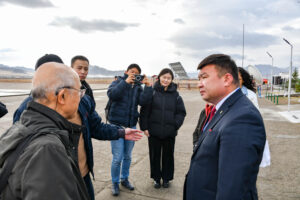
The following day, we boarded an early morning flight to Bayan-Ölgii. Located about 1,300 kilometers from Ulaanbaatar, it was a vivid reminder of just how vast Mongolia is. Upon arrival, we went straight to the Provincial Central Hospital, where we had an opportunity to exchange views with the hospital director. He explained that due to the distance from Ulaanbaatar, access to medical care in Bayan-Ölgii is limited—a type of regional disparity that is unfortunately common in many countries. During previous screenings, I had rarely spoken up during such discussions, but this time, seated beside Dr. Haneda, I offered a few words in hopes of contributing to our mutual friendship and understanding.
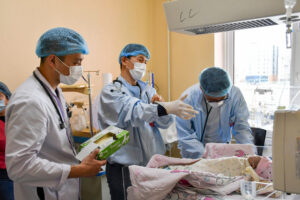 In the afternoon, we began the screening using a part of the hospital. One of the doctors generously lent us their personally owned ultrasound machine, which allowed us to set up a three-consultation team structure. Thanks to effective local publicity, we were able to examine 95 patients on the first day alone. With Mongolia’s economic development, we are increasingly seeing patients who have already been diagnosed with congenital heart disease, or who have undergone surgery in neighboring countries like China, South Korea, or India. However, on the first day in Bayan-Ölgii, we encountered several patients with previously undiagnosed VSDs and ASDs, underscoring the ongoing disparities in access to healthcare depending on one’s place of residence.
In the afternoon, we began the screening using a part of the hospital. One of the doctors generously lent us their personally owned ultrasound machine, which allowed us to set up a three-consultation team structure. Thanks to effective local publicity, we were able to examine 95 patients on the first day alone. With Mongolia’s economic development, we are increasingly seeing patients who have already been diagnosed with congenital heart disease, or who have undergone surgery in neighboring countries like China, South Korea, or India. However, on the first day in Bayan-Ölgii, we encountered several patients with previously undiagnosed VSDs and ASDs, underscoring the ongoing disparities in access to healthcare depending on one’s place of residence.
Among the first-day cases, there was an infant with a large pericardial effusion. Fortunately, their cardiac function was stable, with no signs of tamponade, and the local team judged it safe to transfer the child to Ulaanbaatar. We were also asked to examine a newborn, so Dr. Ono and I brought an echo machine to the NICU. There, we found a day-old infant with a ductal shock due to an interrupted aortic arch. We were told that PGE (prostaglandin E) was not available in the region, and neonatal surgery was not a realistic option. Dr. Bevkbat, who had accompanied us, kindly used his phone to illustrate the anatomy and explain the condition. Yet, all we could do was acknowledge the grim reality that nothing could be done for this baby. I was overwhelmed with a sense of helplessness. We later heard that the infant passed away the following day. While it was some small comfort that we were able to provide a correct diagnosis before the baby’s passing, the thought of the grieving family left a heavy feeling in my heart.
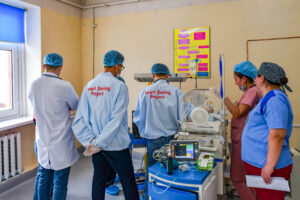
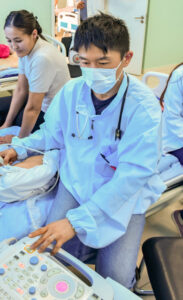 On the second and third days, many more patients came, including one who had reached the Eisenmenger stage without ever undergoing surgery. Still, each of them was continuing their life journey in their own way.
On the second and third days, many more patients came, including one who had reached the Eisenmenger stage without ever undergoing surgery. Still, each of them was continuing their life journey in their own way.
In the end, we examined a total of 286 patients. Among them, 14 appeared to require treatment or invasive evaluation. Notably, 9 of these 14 patients had ASDs, and based on our experience in Japan, most of them seemed likely candidates for device closure. Five of these nine were teenagers, which made it all the more meaningful that we could chart a treatment path before their physical burden increases further.
Ahead of this screening, Dr. Tomita had instructed us to ensure high quality and to develop a system that wouldn’t leave things unfinished. From January, we began identifying issues in both the catheterization and screening teams, seeking ways to improve. In this year’s first regional screening, we made it a rule to summarize the day’s findings on the same day, no matter how exhausted we were. We also put great effort into ensuring that the participating doctors from the Mother and Child Center and the local physicians could clearly understand the cases and their follow-up or treatment needs through well-managed conferences.
Balancing thorough coverage of all necessary cases while keeping conference times short is like performing a handstand on the ceiling—but over the three days, I believe we achieved effective information sharing. I sincerely hope that all 14 patients who require treatment or further evaluation will be successfully placed on a treatment track. While follow-up may be difficult, if even one more patient receives the care they need and the overall health level of the region improves, it would bring me great joy.
Finally, I would like to express my heartfelt thanks to the HSP staff who managed our travel and administrative tasks, the parliamentary aides who accompanied us, and Dr. Bevkbat who traveled from Ulaanbaatar. I am also deeply grateful to the hospital staff in Bayan-Ölgii, who welcomed us warmly and cooperated fully with our screening efforts, despite meeting us for the first time. Through this experience, I was once again reminded of the importance of continuing to contribute in whatever small ways I can—through participation in cardiac catheterization and regional screenings as part of HSP’s activities.
To everyone involved—thank you once again for this invaluable opportunity.
